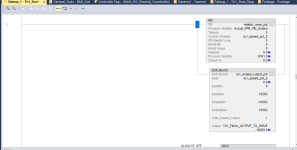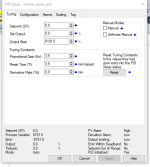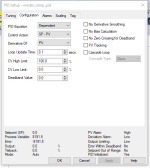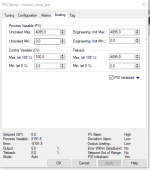csamuelsen
Member
Hello all!
First official post here... have been using the site for help but managed to find existing threads to help with all previous issues.
I recently completed an upgrade project and am having issues getting my PID working that controls the main motor.
A brief overall description is a wire spooling application. One motor to turn the reel, another that lays the wire nice and even. I have the line running off of a very crude ramp function but long term need the arbor motor running on a PID.
I have attached screenshots of the code relating to the PID and will appreciate any and all suggestions as this is my first time actually working with a compact logix.
The issue I am facing is that I see the setpoint changing(feet per minute) once I change the line to a run state. The issue I have here is that the output is never changing from 0. I have scaled the setpoint and process variable before inputting to the PID so that 0 is equal to -600 fpm, 8191 is equal to 0 fpm, and 16383 is equal to +600 fpm. I haven't done any tuning yet so I just entered my default non zero values for kp and ki.
Please throw out any suggestions you may have so I can give it a go.
Cheers
Chris




First official post here... have been using the site for help but managed to find existing threads to help with all previous issues.
I recently completed an upgrade project and am having issues getting my PID working that controls the main motor.
A brief overall description is a wire spooling application. One motor to turn the reel, another that lays the wire nice and even. I have the line running off of a very crude ramp function but long term need the arbor motor running on a PID.
I have attached screenshots of the code relating to the PID and will appreciate any and all suggestions as this is my first time actually working with a compact logix.
The issue I am facing is that I see the setpoint changing(feet per minute) once I change the line to a run state. The issue I have here is that the output is never changing from 0. I have scaled the setpoint and process variable before inputting to the PID so that 0 is equal to -600 fpm, 8191 is equal to 0 fpm, and 16383 is equal to +600 fpm. I haven't done any tuning yet so I just entered my default non zero values for kp and ki.
Please throw out any suggestions you may have so I can give it a go.
Cheers
Chris






